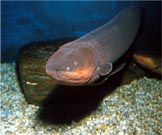Eel’s electricity may pave way for future medical implants
London, October 3:  A team of American scientists from Yale University and the National Institute of Standards and Technology (NIST) says that it is possible to build artificial cells that can replicate the electrical behaviour of electric eels, a fish species that can generate powerful shocks for both hunting and self-defence.
A team of American scientists from Yale University and the National Institute of Standards and Technology (NIST) says that it is possible to build artificial cells that can replicate the electrical behaviour of electric eels, a fish species that can generate powerful shocks for both hunting and self-defence.
The researchers say that artificial versions of the eel’s electricity generating cells may serve as a power source for medical implants and other tiny devices.
NIST engineer David LaVan points out that just like the eel’s cells, artificial cells’ source of energy would be adenosine triphosphate (ATP), synthesized from the body’s sugars and fats using tailored bacteria or mitochondria.
He and his partner Jian Xu have developed a complex numerical model that suggests that an artificial cell can generate over 40 per cent more energy in a single pulse than a natural electrocyte.
Another model suggest that artificial cells can produce peak power outputs over 28 percent higher, LaVan adds.
Based on their observations, the researchers surmise that stacked layers of artificial cells in a cube slightly over 4 mm on a side are capable of producing continuous power output of about 300 microwatts to drive small implant devices.
A research article on the study has been published in the online edition of the journal Nature Nanotechnology. (ANI)